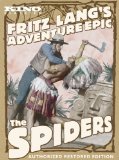| Reviews & Columns |
|
Reviews DVD TV on DVD Blu-ray 4K UHD International DVDs In Theaters Reviews by Studio Video Games Features Collector Series DVDs Easter Egg Database Interviews DVD Talk Radio Feature Articles Columns Anime Talk DVD Savant Horror DVDs The M.O.D. Squad Art House HD Talk Silent DVD
|
DVD Talk Forum |
|
|
| Resources |
|
DVD Price Search Customer Service #'s RCE Info Links |
|
Columns
|
|
|
Spiders: Kino Classics Edition
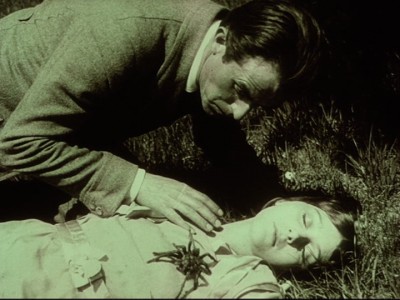
It's a message in a bottle that lights the fuse of Fritz Lang's madcap, whirlwind adventure The Spiders, an early effort from the international master of cinema whose career would go on to encompass such disparate masterpieces as M and Scarlet Street. Though it's two serial features (the first, "The Golden Sea," released in 1919, followed by "The Diamond Ship" in 1920), each of these halves is subdivided into many varying episodes within itself; each part is a burst of action-packed vignettes, one following breathlessly on the heels of the last like a machine-gun round of rousing, riveting (and not particularly rational or realistic, not that it matters) events spattered rapidly onto the screen. There are signs of Lang's directorial signature that do distinguish The Spiders, but what it delivers first and foremost is good old-fashioned cinematic thrills and adventure designed to excite, titillate, and cliffhang just enough to keep you coming back for more. If later, even more distinctive Lang films like his also serial-like Mabuse films Dr. Mabuse, the Gambler and The Testament of Dr. Mabuse, and even bits of his best-known early work, Metropolis, are pulp fiction, this one is straight from the weekly installments of the funny pages.
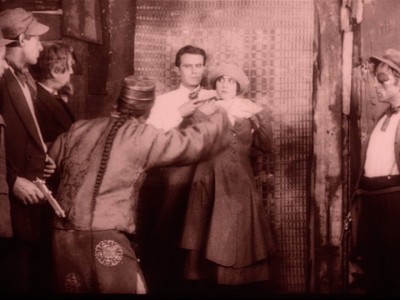
The game-for-anything, peripatetic Tintin figure at the center of The Spiders's potentially never-ending series of adventures is the unusually named Kay Hoog, a bachelor man of leisure who finds the aforementioned message in a bottle while preparing for a San Francisco-to-Japan yacht race. As we have seen from the film's prologue, the note he's retrieved from the waves was drafted and tossed into the sea by a bedraggled, desperate-looking man just at the moment he was shot down by an arrow from the bow of a movie-Indian-looking "savage." (Just to acknowledge it right from the start: This is a movie that exoticizes and exaggerates everything at its most sensitive, and though it is rip-roaring fun whose veins of conventional-wisdom racism one can mock as reflective of a less enlightened time, it would also make a revealing study for anyone interested in how acceptable stereotyping of anything but the white male hero was at the period, as well as something to make Orientalism author Edward Said roll over in his grave.) It turns out that, during a search for a trove of unimaginably valuable treasures, the man shot on the beach (a professor captured while on an expedition) was ultimately killed by a surviving gang of Incans who worship the sun, commit ritual sacrifice, and live atop an underground cache of unimaginable riches. Hoog reads out his discovery at a party of fellow upper-crustians in a country-club party setting, where his intent to bow out of the yacht race and pursue this much more exciting adventure involving exotic locales, strange people, and a hoard of treasures is heard by Lio Sha (Ressel Orla), Hoog's sinister, sly female counterpart.
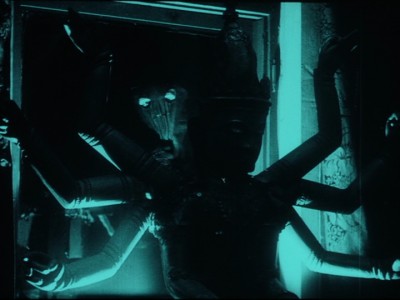
Sha is not just a villain but part of one of the film's more Langian markers: a conspiracy that goes deeper, higher, and is in general inconceivably widespread, lurking around every corner. This shady group of international smugglers, spies, and all-purpose self-interested criminals to whose top ranks Lio belongs to is called "The Spiders" (I don't know about you, but that more figurative meaning set my own arachnophobia somewhat at ease); they leave a dead, giant spider as a calling card at the scenes of their crimes, so that is what Hoog wakes up to after they have broken into his house dressed like ninjas and swiped the message from the bottle, with its revealing coordinates as to the exact location of the treasure. Part 1 of Spiders then becomes a race to the lost Incan city between Hoog and Lio with her Spiders, who follow close behind--a pursuit involving many fights, frenetic sun-worshipping rituals, big snakes, captures, escapes, imminent human sacrifices, and an unwarranted but erotic amount of swooning and writhing on the part of any endangered female. In the end, only Hoog, Sha, and the Incan Sun Princess--torn, like Pocahontas, between her father's order to kill the white man and her love for him--escape the doom that has long awaited the hidden city of treasure. Once safely back home, the tension that's been bubbling between Sha and Hoog rises to the surface with Sha's confession of love for Hoog. "The Golden Sea" then ends with an act of vengeance on Sha's part after Hoog jilts her for Naela, the rescued sun princess and now Hoog's amour, setting the stage for their transformation from mere rivals to out-and-out enemies in "The Diamond Ship."
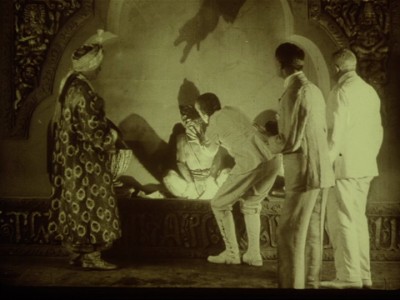
That second half of the Spiders diptych turns its exotica-seeking eye from Mexico to the Far East (via a lawless underground city teeming under Chinatown), into which Hoog, in pursuit of a rare diamond known as "The Buddha's Head," follows the now exceptionally dangerous and increasingly avaricious Lio Sha; finds The Spiders' secret lair under the house of the group's sinister, quasi-Mabuse mastermind, Dr. Telphas (Georg John); nearly gets killed in an opium den while faking intoxication; stows away in a box, which he turns into an ingenious makeshift headquarters, in the hold of The Spiders' diamond-smuggling ship; and is eventually rewarded with the final vanquishment of the dread Lio Sha and Dr. Telphas when their scheme backfires handily on them, as well as what looks like a surefire romance with the diamond king's daughter. The pursuit is more intercontinental this time, too, hopping from the U.S. to England, where a rich "diamond king"'s daughter is kidnapped by The Spiders and held for a Buddha's Head-sized ransom, to the Falkland Islands, where Hoog has discovered the Buddha's Head to have been left by one of the diamond king's pirate ancestors. There's even a detour to India, where some kind of seer/swami, undergoing what an intertitle informs us is "an experiment in hypno-telepathy," is induced to telepathically locate the Buddha's Head for The Spiders with the false enticement that it will be returned to Asia, fulfilling a legend that this will mean the end of foreign, white rule of the continent.
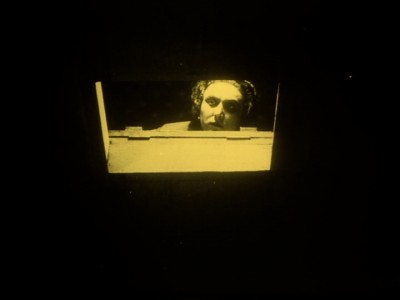
The key to this kind of overstuffed, hypereventful serial storytelling--evident in many examples that we best remember from the silent era and have thus survived the test of time--is to keep the plates spinning so fast that everyone is kept in edge-of-their-seat suspense and nobody cares about the total implausibility of the convoluted plots and near-camp falseness of anything ostensibly historical or ethnographic in the picture. Lang proves himself very adept at concocting (he also wrote the films) and executing the story with the sheer propulsion demanded, stuffing the films with enough chases, narrow escapes, and mysteries--ones that seem to require going deeper and deeper underground into ever more secret compartments to solve--that the silliness (on logical terms) of the whole affair becomes part of its charm in retrospect and is invisible when he's got us immersed in all the nonstop goings-on. The Spiders is certainly on a technical par with the contemporaneous films of Griffith, with its use of intercutting, iris-in techniques, tinting, etc. And that key Langian element--atmosphere--is present to a remarkable degree, too, wrought by the claustrophobic mise-en-scène, geometrical framings and compositions, and shadows that seem to take on a life of their own all creating the general impression that there is another, more sinister world lurking just out of sight, right behind the walls--a space that must be invaded at great risk to get to something, whether it be a treasure or the diabolically hidden, elusive truth. The Spiders is not, like Lang's later, greater works (even when they also, like these films, hew closer to pulp than more rarefied drama) something indelibly penetrating; it doesn't have the power to linger and haunt the way M or Scarlet Street does. It is, however, great fun, a visually captivating and brilliantly spun entertainment with plenty of adrenaline flowing through it--an early entry that makes for a tasty, extremely enjoyable Lang appetizer before his filmography goes on to dig in to the main courses.
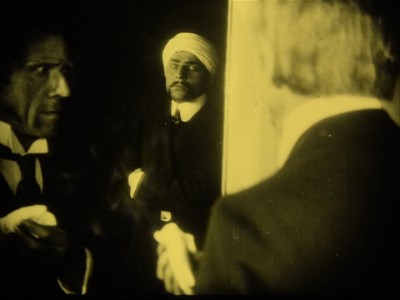
THE DVD:
The source materials are, of course, rather rough (the films are now nearly a century old), but Kino is presenting them in their best-restored, authorized form here, and despite multiple instances of lines, spots, flickering, and blur that bespeak some fairly extensive wear down the decades, the picture quality is more than good enough to convince that as conscientious a transfer as possible was performed to get The Spiders onto DVD in a condition that lets us appreciate its many marvelous visual qualities to the fullest extent possible.
Sound:A score by composer Ben Model is presented in a Dolby Digital 2.0 stereo mix that's perfectly clear, full, and resonant, almost to an alarming extent; it sounds so clear, layered, and well-mixed it seems a bit anachronistic at times when juxtaposed with the typical silent-film signs of age in the visual presentation. But at the level of pure audio quality, the audio is very good.
Extras:A stills gallery featuring about 40 of the more striking images from the film and snapshots of original promotional materials (lobby cards and programs) from the archives of the Deutsch Kinematek.
FINAL THOUGHTS:It's notably more conventional than the Fritz Lang pictures that have become canonical, but The Spiders, a serial-adventure genre standout from the silent era, provides enough undeveloped but recognizable Langian touches to keep the auteurist in you engaged. Just as importantly for its purposes, it also fulfills every requirement of the kind of film it is with aplomb; we're left breathless, hearts racing and all keyed up, when it finally screeches to a halt after what feel like its several adventure-filled trots around the globe. (I can picture kids loving it, actually, but don't show it to them before bed, and that probably goes for many grown-ups, too.) It will thus be not just a treat for foreign-film and film-history obsessives (who will view and be intrigued by it as an early work by Fritz Lang that already shows his tremendous vision and skill, or as a film that showcases the rapid development of style and technique in the cinema) but also an experience easily capable of seducing most any casual moviegoer who had a great time at Raiders of the Lost Ark or The Adventures of Tintin and would just like to get a dose of that cinematic adrenaline from an earlier, distinctively pure source. Recommended.
|
| Popular Reviews |
| Sponsored Links |
|
|
| Sponsored Links |
|
|
| Release List | Reviews | Shop | Newsletter | Forum | DVD Giveaways | Blu-Ray | Advertise |
|
Copyright 2024 DVDTalk.com All Rights Reserved. Legal Info, Privacy Policy, Terms of Use,
Manage Preferences,
Your Privacy Choices | |||||||









